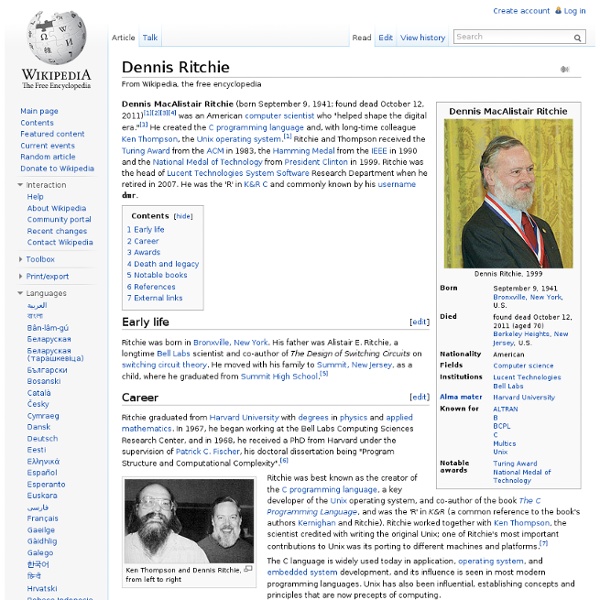C (programming language)
C is one of the most widely used programming languages of all time,[8][9] and C compilers are available for the majority of available computer architectures and operating systems. C is an imperative (procedural) language. It was designed to be compiled using a relatively straightforward compiler, to provide low-level access to memory, to provide language constructs that map efficiently to machine instructions, and to require minimal run-time support. C was therefore useful for many applications that had formerly been coded in assembly language, such as in system programming. Despite its low-level capabilities, the language was designed to encourage cross-platform programming. The C language also exhibits the following characteristics: The origin of C is closely tied to the development of the Unix operating system, originally implemented in assembly language on a PDP-7 by Ritchie and Thompson, incorporating several ideas from colleagues. The cover of the book, The C Programming Language
Douglas McIlroy
His seminal work on software componentization,[1] makes him a pioneer of component-based software engineering and software product line engineering. McIlroy (left) with former colleague Dennis Ritchie at the Japan Prize Foundation in May 2011. Dr. He taught at MIT from 1954 to 1958. McIlroy joined Bell Laboratories in 1958, from 1965-1986 was head of its Computing Techniques Research Department (the birthplace of the Unix operating system), and thereafter was Distinguished Member of Technical Staff. He was a visiting lecturer at Oxford University from 1967 to 1968. McIlroy retired from Bell Labs in 1997, and serves as an Adjunct Professor in the Dartmouth College Computer Science Department. He is a member of the National Academy of Engineering, and has won both the USENIX Lifetime Achievement Award ("The Flame") and its Software Tools award. Quotes[edit] Those types are not "abstract"; they are as real as int and float.As a programmer, it is your job to put yourself out of business.
Go (programming language)
"Google Go" redirects here. For the computer program by Google to play the board game Go, see AlphaGo. Two major implementations exist: With this type definition, ipv4addr(x) interprets the uint32 value x as an IP address. // ZeroBroadcast reports whether addr is 255.255.255.255.func (addr ipv4addr) ZeroBroadcast() bool { return addr == 0xFFFFFFFF} An interface specifies a set of types by listing required methods and their types, and is satisfied by any type that has the required methods. Go critics assert that: The Go authors put substantial effort into molding the style and design of Go programs: Go includes the same sort of debugging, testing, and code-vetting tools as many language distributions. It also includes profiling and debugging support, runtime instrumentation (to, for example, track garbage collection pauses), and a race condition tester. Here is a Hello world program in Go: package main import "fmt" func main() { fmt.Println("Hello, World")}
Endgame tablebase
A typical interface for querying a tablebase An endgame tablebase is a computerized database that contains precalculated exhaustive analysis of a chess endgame position. It is typically used by a computer chess engine during play, or by a human or computer that is retrospectively analysing a game that has already been played. The solutions have profoundly advanced the chess community's understanding of endgame theory. While endgame tablebases for other board games like checkers,[3] chess variants[4] or Nine Men's Morris[5] exist, when a game is not specified, it is assumed to be chess. Background[edit] In 1965, Richard Bellman proposed the creation of a database to solve chess and checkers endgames using retrograde analysis.[9][10] Instead of analyzing forward from the position currently on the board, the database would analyze backward from positions where one player was checkmated or stalemated. More recent contributors have included the following people: Generating tablebases[edit] 1. 2.
Unix
Unix (all-caps UNIX for the trademark) is a family of multitasking, multiuser computer operating systems that derive from the original AT&T Unix, developed in the 1970s at the Bell Labs research center by Ken Thompson, Dennis Ritchie, and others.[3] Many clones of Unix have arisen over the years, of which Linux is the most popular, having overtaken the popularity of "true" Unix on server platforms since its inception in the early 1990s. Overview Originally, Unix was meant to be a programmer's workbench to be used for developing software to be run on multiple platforms[8] more than to be used to run application software. The system grew larger as the operating system started spreading in the academic circle, as users added their own tools to the system and shared them with colleagues.[9] History Standards In 1999, in an effort towards compatibility, several Unix system vendors agreed on SVR4's Executable and Linkable Format (ELF) as the standard for binary and object code files. Components
Ken Thompson
American computer scientist, creator of the Unix operating system Early life and education[edit] Thompson was born in New Orleans. When asked how he learned to program, Thompson stated, "I was always fascinated with logic and even in grade school I'd work on arithmetic problems in binary, stuff like that. Just because I was fascinated." Thompson received a Bachelor of Science in 1965 and a Master's degree in 1966, both in Electrical Engineering and Computer Science, from the University of California, Berkeley, where his master's thesis advisor was Elwyn Berlekamp.[4] Career and research[edit] 1970s[edit] Thompson (sitting) and Ritchie working together at a PDP-11 Throughout the 1970s, Thompson and Ritchie collaborated on the Unix operating system; they were so influential on Research Unix that Doug McIlroy later wrote, "The names of Ritchie and Thompson may safely be assumed to be attached to almost everything not otherwise attributed 1980s[edit] 1990s[edit] 2000s[edit] Awards[edit] Sources
terminology - What is negative code



